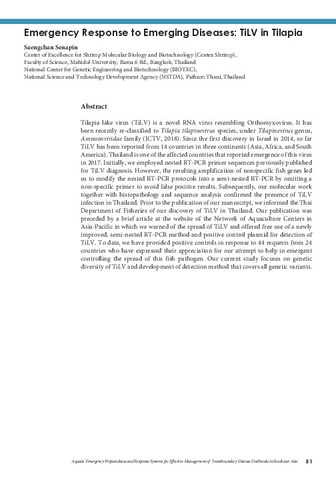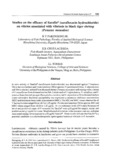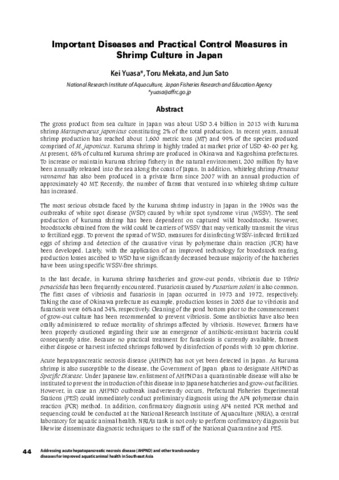Identification of a chromosomally-encoded sucrose operon-like gene cluster in Vibrio parahaemolyticus strain PH05 isolated from Negros Island, Philippines
Share
| dc.contributor.author | De Mesa, Czarina Anne | |
| dc.contributor.author | Mendoza, Remilyn | |
| dc.contributor.author | Amar, Edgar | |
| dc.contributor.author | de la Peña, Leobert D. | |
| dc.contributor.author | Saloma, Cynthia | |
| dc.coverage.spatial | Negros | en |
| dc.date.accessioned | 2022-07-04T03:51:50Z | |
| dc.date.available | 2022-07-04T03:51:50Z | |
| dc.date.issued | 2021-02-27 | |
| dc.identifier.citation | De Mesa, C. A. E., Mendoza, R. M., Amar, E. C., de la Peña, L. D., & Saloma, C. P. (2021). Identification of a chromosomally-encoded sucrose operon-like gene cluster in Vibrio parahaemolyticus strain PH05 isolated from Negros Island, Philippines [Preprint]. bioRxiv. https://doi.org/10.1101/2021.02.27.433172 | en |
| dc.identifier.uri | http://hdl.handle.net/10862/6337 | |
| dc.description.abstract | The ability of bacteria to metabolize a wide variety of carbon sources has been known to aid in their ability for efficient colonization. Vibrio parahaemolyticus, a known aquatic pathogen has been reported to have the ability to metabolize a number of carbohydrates including D-glucose, D-galactose, L-arabinose, D-mannose, and D-ribose to name a few. Classical isolation of V. parahaemolyticus from other members of the family Vibrionaceae relies on its carbon utilization pattern. Conventionally, V. parahaemolyticus lacks the ability to utilize sucrose and this has been the basis for its isolation using the Thiosulfate-citrate-bile salts-sucrose (TCBS) agar. Reports of V. parahaemolyticus having the ability to utilize sucrose have been presented yet there is paucity of information and detailed study on this phenotype. In this study, we report the V. parahaemolyticus strain PH05 that has the ability to metabolize sucrose. Phenotypic and genotypic characterization of this V. parahaemolyticus strain isolated from Negros Island, Philippines, revealed that V. parahaemolyticus strain PH05 is atypical appearing yellow on TCBS agar plates. It is capable of utilizing sucrose, unlike the majority of V. parahaemolyticus isolates. Genome analyses of this strain revealed the presence of a chromosomally encoded sucrose operon-like gene cluster encoded in chromosome 2 with the following sucrose-utilization associated genes: scrY, ccpA, treP, scrK, and scrB genes coding for sucrose porin, catabolite control protein A, PTS System sucrose-specific EIIBC component, fructokinase, and sucrose-6-phosphate hydrolase. The mode of transmission of these genes to V. parahaemolyticus strain PH05 is still unknown. However, the presence of insertion sequences (IS) and phage elements in the same chromosome suggests horizontal gene transfer events. Taken together, our results point to the possibility that acquired sucrose utilization genes may contribute to the fitness of V. parahaemolyticus strain PH05 in the environment. | en |
| dc.description.sponsorship | This work was supported by a Department of Science and Technology, Philippine Council for Agriculture, Aquatic and Natural Resources Research and Development (DOST-PCAARRD) grant to CPS, EAA, LDD, and a DOST Science Education Institute fellowship to CADM and RMM. | en |
| dc.language.iso | en | en |
| dc.publisher | Cold Spring Harbor Laboratory | en |
| dc.relation.uri | https://www.biorxiv.org/content/10.1101/2021.02.27.433172v1.full.pdf | en |
| dc.subject | Vibrio parahaemolyticus | en |
| dc.subject | Philippines | en |
| dc.title | Identification of a chromosomally-encoded sucrose operon-like gene cluster in Vibrio parahaemolyticus strain PH05 isolated from Negros Island, Philippines | en |
| dc.type | Preprint | en |
| dc.citation.journalTitle | bioRxiv | en |
| dc.subject.asfa | pathogens | en |
| dc.subject.asfa | pathogenic bacteria | en |
| dc.subject.asfa | genomes | en |
| dc.subject.asfa | chromosomes | en |
| dc.subject.asfa | phenotypes | en |
| dc.identifier.doi | 10.1101/2021.02.27.433172 | |
| dc.subject.scientificName | Vibrio parahaemolyticus | en |
| dc.subject.scientificName | Vibrio | en |
| local.subject | Vibrio parahaemolyticus | en |
| local.subject | atypical | en |
| local.subject | sucrose | en |
| local.subject | gene cluster | en |
| local.subject | operon | en |
Files in this item
| Files | Size | Format | View |
|---|---|---|---|
| 2021.02.27.433172v1.full.pdf | 1.213Mb | application/pdf | View/ |
This item appears in the following Collection(s)
-
AQD Journal Articles [1249]
These papers were contributed by AQD staff to various national and international journals



